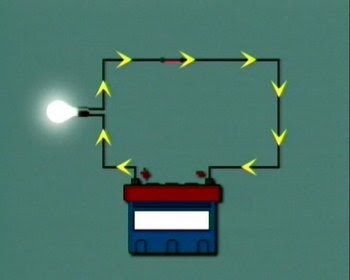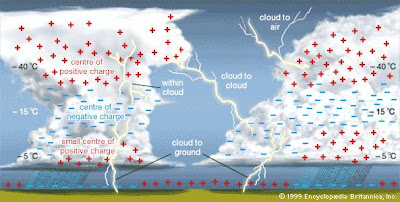Electricity has been important to humans for many years. Around 500 B.C. a Greek philosopher named Thales first discovered electricity when he learned that when amber is rubbed with cloth, small bits of straw are attracted. Queen Elizabeth, the Queen of England, discovered that diamonds, glass, sulfur and wax act like amber.
In 1706, Benjamin Franklin a famous scientist was born. In 1746, Ben Franklin started experiments with electricity. While trying to prove lightning was electricity he flew a kite in a lightning storm with a key at the end and the lightning touched the key which made a spark. From this, he made a metal rod to go on a roof so the houses would have no damage.
Depite what you have learned, Benjamin Franklin did not "invent" electricity. In fact, electricity did not begin when Benjamin Franklin at when he flew his kite during a thunderstorm or when light bulbs were installed in houses all around the world.
The truth is that electricity has always been around because it naturally exists in the world. Lightning, for instance, is simply a flow of electrons between the ground and the clouds. When you touch something and get a shock, that is really static electricity moving toward you.
Hence, electrical equipment like motors, light bulbs, and batteries aren't needed for electricity to exist. They are just creative inventions designed to harness and use electricity.
The first discoveries of electricity were made back in ancient Greece. Greek philosophers discovered that when amber is rubbed against cloth, lightweight objects will stick to it. This is the basis of static electricity.
Over the centuries, there have been many discoveries made about electricity. We've all heard of famous people like Benjamin Franklin and Thomas Edison, but there have been many other inventors throughout history that were each a part in the development of electricity.
Electricity Personalities from Electricity ForumBenjamin Franklin
Franklin was an American writer, publisher, scientist and diplomat, who helped to draw up the famous Declaration of Independence and the US Constitution. In 1752 Franklin proved that lightning and the spark from amber were one and the same thing. The story of this famous milestone is a familiar one, in which Franklin fastened an iron spike to a silken kite, which he flew during a thunderstorm, while holding the end of the kite string by an iron key. When lightening flashed, a tiny spark jumped from the key to his wrist. The experiment proved Franklin's theory, but was extremely dangerous - He could easily have been killed.
Galvani and Volta

Luigi Galvani and Alessandro Volta
In 1786, Luigi Galvani, an Italian professor of medicine, found that when the leg of a dead frog was touched by a metal knife, the leg twitched violently. Galvani thought that the muscles of the frog must contain electricity. By 1792 another Italian scientist, Alessandro Volta, disagreed: he realised that the main factors in Galvani's discovery were the two different metals - the steel knife and the tin plate - apon which the frog was lying. Volta showed that when moisture comes between two different metals, electricity is created. This led him to invent the first electric battery, the voltaic pile, which he made from thin sheets of copper and zinc separated by moist pasteboard.
In this way, a new kind of electricity was discovered, electricity that flowed steadily like a current of water instead of discharging itself in a single spark or shock. Volta showed that electricity could be made to travel from one place to another by wire, thereby making an important contribution to the science of electricity. The unit of electrical potential, the Volt, is named after Volta.
Michael Faraday
The credit for generating electric current on a practical scale goes to the famous English scientist, Michael Faraday. Faraday was greatly interested in the invention of the electromagnet, but his brilliant mind took earlier experiments still further. If electricity could produce magnetism, why couldn't magnetism produce electricity.
In 1831, Faraday found the solution. Electricity could be produced through magnetism by motion. He discovered that when a magnet was moved inside a coil of copper wire, a tiny electric current flows through the wire. Of course, by today's standards, Faraday's electric dynamo or electric generator was crude, and provided only a small electric current be he discovered the first method of generating electricity by means of motion in a magnetic field.
Thomas Edison and Joseph Swan
Thomas Edison and Joseph Swan
Nearly 40 years went by before a really practical DC (Direct Current) generator was built by Thomas Edison in America. Edison's many inventions included the phonograph and an improved printing telegraph. In 1878 Joseph Swan, a British scientist, invented the incandescent filament lamp and within twelve months Edison made a similar discovery in America.
Swan and Edison later set up a joint company to produce the first practical filament lamp. Prior to this, electric lighting had been my crude arc lamps.
Edison used his DC generator to provide electricity to light his laboratory and later to illuminate the first New York street to be lit by electric lamps, in September 1882. Edison's successes were not without controversy, however - although he was convinced of the merits of DC for generating electricity, other scientists in Europe and America recognised that DC brought major disadvantages.
George Westinghouse and Nikola Tesla
George Westinghouse and Nikola Tesla
Westinghouse was a famous American inventor and industrialist who purchased and developed Nikola Tesla's patented motor for generating alternating current. The work of Westinghouse, Tesla and others gradually persuaded American society that the future lay with AC rather than DC (Adoption of AC generation enabled the transmission of large blocks of electrical, power using higher voltages via transformers, which would have been impossible otherwise). Today the unit of measurement for magnetic fields commemorates Tesla's name.
James Watt
When Edison's generator was coupled with Watt's steam engine, large scale electricity generation became a practical proposition. James Watt, the Scottish inventor of the steam condensing engine, was born in 1736. His improvements to steam engines were patented over a period of 15 years, starting in 1769 and his name was given to the electric unit of power, the Watt.
Watt's engines used the reciprocating piston, however, today's thermal power stations use steam turbines, following the Rankine cycle, worked out by another famous Scottish engineer, William J.M Rankine, in 1859.
Andre Ampere and George Ohm
Andre Ampere and George Ohm
Andre Marie Ampere, a French mathematician who devoted himself to the study of electricity and magnetism, was the first to explain the electro-dynamic theory. A permanent memorial to Ampere is the use of his name for the unit of electric current.
George Simon Ohm, a German mathematician and physicist, was a college teacher in Cologne when in 1827 he published, "The galvanic Circuit Investigated Mathematically". His theories were coldly received by German scientists but his research was recognised in Britain and he was awarded the Copley Medal in 1841. His name has been given to the unit of electrical resistance.























 http://outdoor-lightszone.com
http://outdoor-lightszone.com